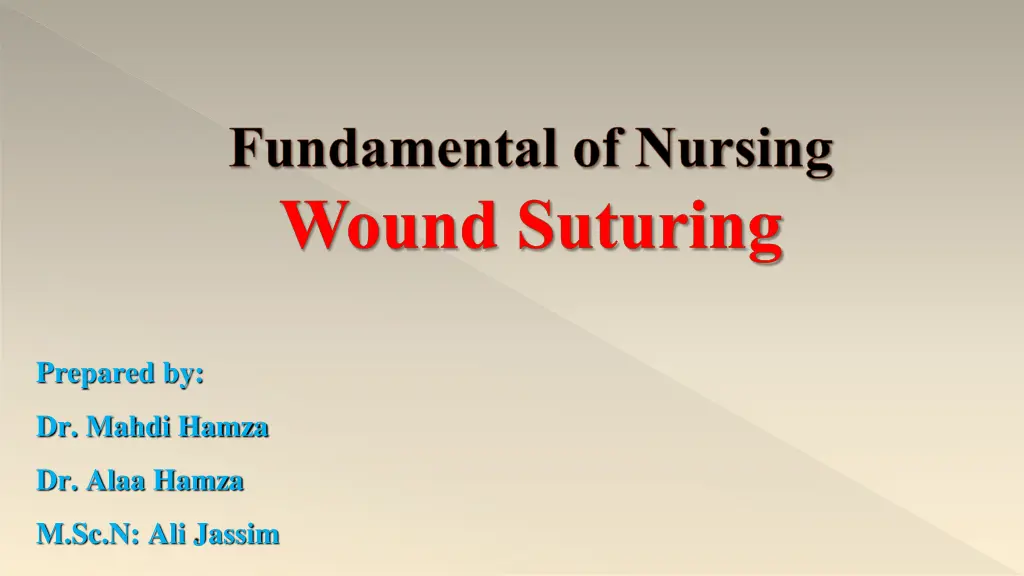
Nursing Wound Suturing Guide for Effective Wound Care
Learn the essential steps and techniques for wound suturing in nursing, along with the types of suture materials used. Understand the preparation of the wound, choice of needles, and different types of sutures to ensure proper wound closure and healing.
Download Presentation

Please find below an Image/Link to download the presentation.
The content on the website is provided AS IS for your information and personal use only. It may not be sold, licensed, or shared on other websites without obtaining consent from the author. If you encounter any issues during the download, it is possible that the publisher has removed the file from their server.
You are allowed to download the files provided on this website for personal or commercial use, subject to the condition that they are used lawfully. All files are the property of their respective owners.
The content on the website is provided AS IS for your information and personal use only. It may not be sold, licensed, or shared on other websites without obtaining consent from the author.
E N D
Presentation Transcript
Fundamental of Nursing Wound Suturing Prepared by: Dr. Mahdi Hamza Dr. Alaa Hamza M.Sc.N: Ali Jassim
Preparing the Wound First, shave the area surrounding the wound to avoid contamination. The wound edges should be exposed and clearly visible. Ideally, there should be a half-inch diameter of hair-free skin surrounding the wound. Irrigating and washing the wound will remove bacteria and debris. Following wound irrigation, pat the wound dry using a sterile gauze pad.
Betadine Scrub & Solution (dilute iodine) Gauze Pad
Equipment's Needle Holders. Scissors Forceps (contain on teeth's) Needed for Suturing (Curved Needle)
Curved Needle Curved needles are the best needle you can use in the suturing process. The curved needle are shaped like an arc to make the job easier and faster. This needle can be used for any type of suture: continuous, Interrupted, or Blanket.
Types of Curved Needle Rounding Cutting
Suture Materials Suture materials can be divided into two categories: absorbable and non-absorbable. Absorbable materials have the advantage in that they are less likely to cause an immune response by the body Non-absorbable materials can be left in the body permanently if needed.
Absorbable Suture Materials Absorbable suture materials are broken down by the patient s body. The original absorbable material was chromic catgut (still used today). This is made from animal intestines and breaks down after 7 days. Because it breaks down, there is less of a likelihood of an immune reaction. EX. Catgut Dexon Vicryl
Non-absorbable Suture Materials Non-absorbable sutures are made of materials that are not readily broken down by the body s enzymes or by hydrolysis. Non-absorbable materials can be removed or left in place permanently EX. Silk Nylon Proline Darcron
Coordinated Use of the Forceps and Needle Holder The tip of the needle holder should grasp the needle about 2/3 of the way back from the tip. The needle holder and needle should be perpendicular to each other. The tip of the needle should penetrate the skin perpendicularly about 5-10 mm from the wound edge. Elevate the skin with the forceps while penetrating the skin. 90*
Forceps & Needle (Cont) The tip of the needle should now be seen protruding into the wound At this point, continue to hold the skin with the forceps. A common error here is to release the forceps from the skin edge This would cause the skin to retract, and the needle may move and retract beneath the skin edge
Forceps and Needle (cont) The key is to hold the position of the skin edge while releasing the needle from the needle holder. Pull the needle from the other side of the elevated skin. Elevate the other skin edge and penetrate it with the needle.
The most common Type of Sutures:- Simple Interrupted Suture Also called an Interrupted Stitch. Each stitch is tied separately. It be used in skin or underlying tissue layers. This stitch has the benefit of creating a more accurate fit for the edges of the wound.
Suture Removal Sutures should be removed from the Face: 3-4 days Scalp: 5 days Trunk: 7 days Arm or leg: 7-10 days Foot 10-14 days
Suture Removal Steps With the suture gently elevated, snip the suture with a scissors. The suture is then gently removed by pulling with the forceps. It is frequently a good idea to reinforce the wound with adhesive strips or tape to prevent it from re-opening.






















